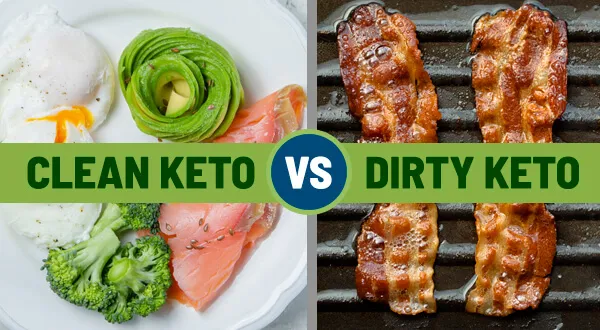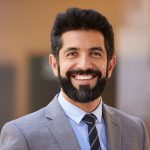Table of Contents
ToggleThe keto vs. clean keto debate is a hot topic in the world of nutrition. Many people have made it to the top level of their health and fitness journey using strict or “ketogenic” dieting, but there are also those who aren’t so sure it’s right for them. The good news is that you don’t need to choose between one or the other! In fact, you can find a diet that will fit your lifestyle and your goals whether you’re following a strict keto regimen or not.
Explaining the Ketogenic Diet

Definition and Principles of the Ketogenic Diet
The ketogenic diet, also known as the keto diet, is a low-carbohydrate, high-fat diet that aims to shift the body’s primary source of fuel from glucose to ketones. By significantly reducing carbohydrate intake and increasing fat consumption, the body enters a metabolic state called ketosis. This dietary approach emphasizes foods such as meat, fish, eggs, nuts, seeds, oils, and low-carbohydrate vegetables while limiting or avoiding grains, legumes, fruits, and sugars. The goal is to force the body to burn stored fat for energy, resulting in weight loss and other potential health benefits.
How the Body Enters a State of Ketosis
Entering a state of ketosis requires depleting the body’s glycogen stores, which are the stored form of glucose. This typically occurs after several days to a week of following a low-carbohydrate diet. As glycogen levels decrease, the liver starts producing ketones, which serve as an alternative energy source for the brain and muscles. Once the body adapts to using ketones as fuel, it becomes efficient at burning fat and maintaining ketosis.
Benefits and Potential Drawbacks of the Ketogenic Diet
The ketogenic diet has been associated with various benefits. Firstly, it has shown promising results for weight loss, as the body utilizes stored fat for energy. Additionally, the diet may help improve blood sugar control and increase feelings of satiety, potentially benefiting individuals with diabetes or those struggling with hunger management. The keto diet has also demonstrated therapeutic potential for conditions like epilepsy, metabolic syndrome, and neurodegenerative diseases.
However, it is important to consider potential drawbacks. The restrictive nature of the diet can lead to nutrient deficiencies if not carefully planned. Common side effects include constipation and the “keto flu,” which may cause fatigue, dizziness, and irritability during the initial adaptation phase. Moreover, individuals with certain health conditions, such as pancreatitis or liver disease, should avoid the ketogenic diet due to the risk of ketoacidosis.
The Concept of Dirty Keto
Definition and Explanation of Dirty Keto
Dirty Keto emphasizes macronutrient ratios over food quality. The approach involves prioritizing the desired ratio of carbohydrates, proteins, and fats while disregarding the nutritional value and sourcing of those nutrients. Instead of focusing on consuming nutrient-dense, whole foods, Dirty Keto allows for more flexibility and indulgence in processed and low-quality food choices. While adhering to the macronutrient ratios, individuals may consume fast food, processed snacks, and desserts.
Perceived Advantages of Dirty Keto
The perceived advantage of Dirty Keto lies in its flexibility. It allows individuals to follow the ketogenic macronutrient ratios while enjoying a wider range of food choices, including traditionally “unhealthy” options. This flexibility can make it easier for some people to adhere to the diet and sustain their weight loss efforts.
Potential Challenges of Clean Keto
Clean Keto is a dietary approach that emphasizes the consumption of nutrient-dense, whole foods while prioritizing quality fats from organic sources. By focusing on whole foods, clean keto aims to support overall health and well-being.
Clean Keto: Focusing on Nutrient-Dense, Whole Foods
In clean keto, the emphasis is on eating unprocessed, natural foods that provide essential nutrients, vitamins, and minerals. The goal is to nourish the body with wholesome, nutrient-dense foods, such as leafy greens, lean proteins, and low-carbohydrate vegetables. By incorporating these foods, clean keto ensures that the body receives a wide range of nutrients necessary for optimal functioning.
Prioritizing Quality Fats and Organic Sources
Clean keto places a strong emphasis on the quality of fats consumed. Opting for high-quality sources of fats, such as avocados, nuts, and olive oil, provides sustained energy and promotes satiety. Furthermore, choosing organic sources ensures a reduced intake of potentially harmful chemicals and pesticides, supporting overall health and well-being.
Benefits of Clean Keto
Clean keto offers several benefits for individuals following this approach. It can lead to improved weight management by promoting fat burning and reducing cravings for processed and high-carbohydrate foods. Additionally, clean keto has been associated with increased mental clarity and focus, improved energy levels, and stabilized blood sugar levels.
Potential Challenges of Clean Keto
While clean keto offers many benefits, it may pose challenges for individuals who find it difficult to strictly restrict their carbohydrate intake. Adhering to a low-carbohydrate diet can require careful meal planning and adjustments to everyday eating habits. Moreover, sourcing organic and high-quality ingredients can be more expensive and may require additional effort.
Key Differences between Dirty Keto and Clean Keto
Macronutrient Ratios and Food Quality Variations
Dirty Keto: Prioritizing Macros over Food Quality
Clean Keto: Emphasizing Nutrient-Dense Foods
The macronutrient ratios and food quality variations are the primary differentiating factors between Dirty Keto and Clean Keto. In Dirty Keto, the main focus is on meeting the macronutrient requirements of the ketogenic diet, with little consideration for the quality of food sources. This approach allows for the consumption of processed and low-quality foods as long as they fit within the desired macronutrient ratios. On the other hand, Clean Keto places a strong emphasis on consuming high-quality, nutrient-dense foods while still maintaining the same macronutrient ratios. This means opting for whole, unprocessed foods such as lean meats, vegetables, and healthy fats.
Impact on Weight Loss and Overall Health
Dirty Keto: Limited Health Benefits
Clean Keto: Superior Weight Loss and Overall Health
When it comes to weight loss and overall health, Clean Keto is often considered superior. The focus on nutrient-rich foods in Clean Keto provides the body with a wide range of essential vitamins, minerals, and antioxidants, which can support overall health and well-being. Additionally, the higher quality of food sources in Clean Keto may lead to improved satiety, better energy levels, and enhanced metabolic function, ultimately aiding in weight loss efforts.
Potential Effects on Inflammation and Gut Health
Dirty Keto: Increased Inflammation and Negative Gut Health
Clean Keto: Reduced Inflammation and Improved Gut Health
The food choices in Dirty Keto may contribute to increased inflammation and negatively impact gut health. Processed and low-quality foods often contain additives, preservatives, and unhealthy fats, which can promote inflammation in the body. In contrast, Clean Keto’s focus on whole foods can provide beneficial fiber, prebiotics, and probiotics, promoting a healthy gut microbiome and reducing inflammation. By prioritizing food quality, Clean Keto offers a more holistic and health-conscious approach to the ketogenic diet.
Impact on Energy Levels and Physical Performance
Comparing Weight Loss and Sustainability
When comparing weight loss and sustainability between Dirty Keto and Clean Keto, notable disparities arise. Dirty Keto, which focuses on meeting macronutrient ratios while allowing for low-quality food choices, may initially result in weight loss due to reduced calorie intake. However, sustaining these results can be challenging due to inadequate nutrient density and potential health risks associated with the consumption of processed and unhealthy foods. Clean Keto, on the other hand, prioritizes nutrient-dense, whole foods, emphasizing high-quality fats, proteins, and carbohydrates. This approach promotes sustainable weight loss and overall well-being, as it ensures the body receives essential vitamins, minerals, and antioxidants. By fueling the body with wholesome foods, Clean Keto enhances energy levels and optimizes physical performance, supporting individuals in achieving their fitness goals more effectively. Thus, when considering weight loss and sustainability, Clean Keto emerges as a superior approach.
Impact on Energy Levels and Physical Performance
The impact on energy levels and physical performance is significantly different between Dirty Keto and Clean Keto approaches. Dirty Keto’s reliance on low-quality food choices can result in fluctuations in energy levels, as processed and unhealthy foods may not provide sustained fuel. In contrast, Clean Keto, with its emphasis on nutrient-dense, whole foods, ensures a steady supply of energy throughout the day. By consuming high-quality fats, proteins, and carbohydrates, individuals following Clean Keto experience improved energy levels, enhanced endurance, and increased stamina. This, in turn, positively affects physical performance, allowing for better workouts, improved recovery, and the ability to achieve fitness goals more efficiently.
Role of Nutrient Density in Achieving Optimal Results
Nutrient density plays a crucial role in attaining optimal results in weight loss and performance when comparing Dirty Keto and Clean Keto. Dirty Keto, with its permissive approach to low-quality foods, may lead to weight loss initially due to reduced calorie intake. However, the lack of nutrient-dense options can result in nutritional deficiencies and potential health risks. Clean Keto, on the other hand, focuses on whole foods that are rich in essential nutrients. By prioritizing nutrient density, Clean Keto ensures that the body receives the necessary vitamins, minerals, and antioxidants, supporting overall well-being and enhancing weight loss efforts. The inclusion of wholesome foods in Clean Keto not only promotes sustained weight loss but also provides the necessary fuel for optimal physical performance. By nourishing the body with nutrient-dense options, individuals following Clean Keto can achieve their desired results more effectively and maintain long-term health and vitality.
Finding Your Keto Style
Identifying Personal Health Goals and Priorities
When it comes to adopting a ketogenic (keto) diet, the first step in finding your keto style is to identify your personal health goals and priorities. Take an active approach by setting specific objectives, whether it’s weight loss, improved energy levels, or better blood sugar control. By defining these goals, you can tailor your keto style to meet your individual needs and stay motivated on your journey.
Considering Lifestyle Factors and Dietary Preferences
Another crucial aspect of finding your keto style is considering your lifestyle factors and dietary preferences. Take into account your daily routine, work schedule, and social activities. Finding a balance that allows you to adhere to the diet while still enjoying meals and socializing with friends and family is key. Whether you prefer cooking elaborate meals or need quick and convenient options, incorporating these preferences into your keto style will make it more sustainable and enjoyable in the long run.
Consulting with Healthcare Professionals or Nutritionists
To ensure you’re on the right track, it is highly recommended to consult with healthcare professionals or nutritionists when finding your keto style. These experts can provide valuable guidance based on your specific health needs and any existing medical conditions. They can offer personalized advice on macronutrient ratios, supplementation, and potential modifications to suit your unique requirements. By seeking professional guidance, you can ensure that your chosen keto style aligns with your overall health and well-being.











